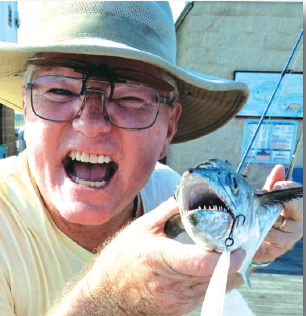Pier & Shore Fishing Outlook 3/8/23
Pier & Shore Fishing Outlook 3/8/23
By David “The Pierpounder” Thornton
March definitely “came in like a lion”, with the big blow that pounded the Gulf beaches to start the month. But nature’s pendulum swings quickly, so the water may calm and clear soon.
The above average temperatures we experienced through February have boosted coastal water temperatures into the lower 70s. That range we typically do not see until late April! So, if fishing follows suit we should see a rapid influx of pompano and spanish mackerel into the area through this fortnight. The Full moon on March 7th is followed by a two-day NEAP tide period. Likewise, the subsequent New moon on the 21st will be followed by a NEAP tide also. The week between will have the strongest tidal fluctuations, nearly two feet some days. The highest tide will be later in the afternoon mainly due to the time change on Sunday March 12th. Plan your fishing trips around these factors to time with the tide movements.
The annual sheepshead spawn should near peak activity this month, coinciding with the arrival of more pompano and increasing schools of Spanish mackerel. Look for mackerel from the west jetty at Perdido Pass, or from the Gulf State Park Pier. Anglers like the 7/8 or 1 ounce Gotcha plug for Spanish because they sink so fast to the migrating mackerel in deeper water.
But the 5/8 ounce white Looney jig works about as well without the increased risk of being accidentally hooked by the two trebles. Either one needs some protection from those razor sharp mackerel teeth. So adding a foot or more of 40# clear monofilament leader will help prevent cut-offs.
Spanish mackerel have been a favorite target species for pier and jetty anglers for decades from the time they show up in March, until they migrate away in late October. They are noted for their darting speed and short runs on medium to light tackle. The early arrivals are usually 12 to 16 inches long, measured nose to the inside of the fork in the tail. These fish weigh up to a pound and a half, and are exceptionally lean after their migration from the coastal waters off southwest Florida. They are a popular food fish and make up a high percentage of the effort by warm water pier anglers.
Spanish mackerel have thin skin with very small scales that easily come off when handled, and are considered a bit bloody and oily. The easiest way to treat them is to have a 5-gallon bucket half filled with seawater at the ready. Many anglers handle their mackerel with a wet hand towel or glove to remove the hook. Then slip a finger or knife between the gill rakers and pull toward the mouth to sever the base of the gill rakers. Place it head first into the bucket of water to bleed the fish which should be placed on ice a few minutes later once it stops bleeding. This is a humane way to deal with what can be a “messy” catch otherwise.
Many other pier anglers will be occupied with targeting either pompano with set-rigs or drift fishing, or sheepshead around the piling. While pompano are still far from peak abundance at the pier, sheepshead are probably at their peak now.
The two most popular approaches are with fiddler crabs or small live shrimp as bait, suspended between the piling or near the bottom. The trick is to use just enough weight to get the bait in front of sheepshead depending on the conditions.
In dingy water with wind and waves moving the bait around, more weight (up to 3 ounces) may be required.
But in calm conditions, especially when the water is clear, a lighter tackle approach in often needed to get these savvy fish to bite. But your tackle still needs to be heavy enough to keep them away from the barnacle encrusted piling. Sheepshead average two to four pounds, but six to even 10 pounders are not uncommon.
Beach fishermen (while dodging spring breakers) will mainly be targeting pompano, though numbers of redfish and drum will be available as well, along with Gulf kingfish (aka whiting). Like pompano, whiting will be aggregating in the surfzone to feed prior to their upcoming spawn. Usually the largest of these species are roe-laden females, so keep conservation in mind when you are planning on retaining some of these delicious fish for a meal or two.
Also, once sheepshead spawn, they tend to stage in the surf for a while. They feed heavily on available invertebrates like ghost shrimp and the increasing numbers of mole crabs (sand fleas). Each March, some sheepshead are caught incidentally by anglers targeting pompano with double drop rigs baited with fresh or live shrimp intended for pompano.
With the onset of Spring Breaks, more anglers start competing for the bait supply at area bait shops.
There may be days at a time when NO live bait is available at any of these stores. They are doing their best to keep up with demand, but early spring is also a time when live shrimp are especially scarce in the wild. So be patient, or better yet buy a ghost shrimp pump to gather your own bait. That just adds to the enjoyment factor.

